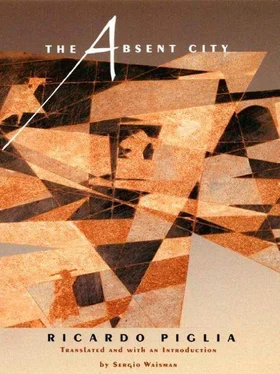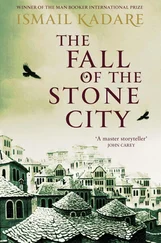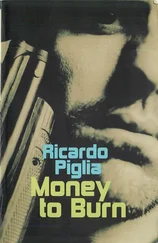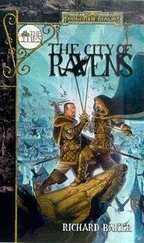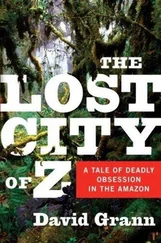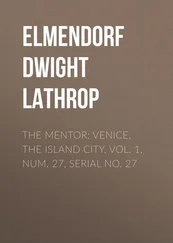The mirror’s wooden frame was marked with gray notches, as if someone had chiseled it with a letter opener. Junior looked at his own face and saw the gallery reflected behind him. The guard had been following him silently at a distance. But now he walked up to him, one hand behind his back and the specter of the other in his pocket, and swallowed, or so Junior thought from the movement of his Adam’s apple.
“What’s that?” Junior asked, pointing to a glass box.
“Science has not yet been able to determine its nature,” he answered with an obviously memorized phrase. “A vulture, or perhaps a chimango. It was found in 1895 in the area outside Tapalqué by Doctor Roger Fontaine, a French scientist,” he said as his shaking finger pointed at the bronze placard.
Inside the case there was a metal bird perched on a branch, pecking at one of its wings.
“Strange,” Junior said.
“And now look at this skull,” the guard said. “It’s from the same region.”
It looked like a glass cranium. The Argentine countryside is inexhaustible. In small towns people hold onto the remnants of the oldest of stories.
Next to it there was a series of objects lined up inside a low glass cabinet, all made out of bone. They looked like dice, or small knuckle-bones with which boys might play, or heretical rosary beads. Junior stopped to look at a Japanese vase, probably donated by some navy officer. He had seen a replica at the market in Plaza Francia, they could make reproductions so precise that they were better than the original. They could even get the copy to look older and more pure. The guard had disappeared quietly out a side stairwell. Junior walked through a gallery containing drawings and photographs from the police archives, and entered another hall. It was a room in a family’s house, the blinds drawn and a lamplight on, without any furniture. A little further down, almost at floor level, in the middle of the room, as if it were in a cradle, was the doll.
The matrimony’s first two children were able to lead a normal life, especially considering the difficulties associated with having a sister like her in a small town. The girl (Laura) was born healthy. It was only with time that they began to notice certain strange signs. Her system of hallucinations was the topic of a complicated report that appeared in a scientific journal, but her father had deciphered it long before that. Yves Fonagy called it “extravagant references.” In these highly unusual cases the patient imagines that everything that occurs around him is a projection of his personality. The patient excludes real people from his experience, because he considers himself much more intelligent than anyone else. The world was an extension of herself; her body spread outward and reproduced itself. She was constantly preoccupied by mechanical objects, especially electric lightbulbs. She saw them as words, every time one was turned on it was like someone had begun to speak. Thus she considered darkness to be a form of silent thinking. One summer afternoon (when she was five years old) she looked at an electric fan spinning on a dresser. She thought it was a living being, a female living being. The girl of the air, her soul trapped in a cage. Laura said that she lived “there,” and raised her hand to indicate the ceiling. There, she said, moving her head from left to right. Her mother turned off the fan. That is when she began having difficulties with language. She lost the capacity to use personal pronouns. With time she stopped using them altogether, then hid all the words she knew in her memory. She would only utter a little clucking sound as she opened and closed her eyes. The mother separated the boys from their sister because she was afraid that it was contagious. One of those small town beliefs. But madness is not contagious and the girl was not crazy. In any case, they sent the two brothers to a Catholic boarding school in Del Valle, and the family went into seclusion in their large house in Bolívar. The father was a frustrated musician who taught mathematics in the public high school. The mother was a teacher and had become principal, but she decided to retire in order to take care of her daughter. They did not want to have her committed. So they took her twice a week to an institute in La Plata and followed the orders given by Doctor Arana, who treated her with electric shock therapy. He explained that the girl lived in an extreme emotional void. That is why Laura’s language was slowly becoming more and more abstract and unpersonalized. At first she still used the correct names for food. She would say “butter,” “sugar,” “water,” but later began to refer to different food items in groups that were disconnected from their nutritive nature. Sugar became “white sand,” butter, “soft mud,” water, “wet air.” It was clear that by disarranging the names and abandoning personal pronouns she was creating a language that better corresponded to her personal emotional experiences. Far from not knowing how to use words correctly, what could be seen was a spontaneous decision to create a language that matched her experience of the world. Doctor Arana did not agree, but this was the father’s hypothesis, and he decided to enter his daughter’s verbal world. She was a logic machine connected to the incorrect interface. The girl functioned according to the model of a fan — a fixed rotational axis served as her syntactic schema, and she moved her head as she spoke to feel the wind of her unarticulated thoughts. The decision to teach her how to use language implied also having to explain to her how to compartmentalize words. But she would lose them like molecules in warm air. Her memory was a breeze blowing in the white curtains of a room in an empty house. It was necessary to try to take that sailboat out in still air. The father stopped going to Doctor Arana’s clinic and began treating the girl with a singing teacher. He had to give her a temporal sequence, and he believed that music was an abstract model of the order of things in the world. She sang Mozart arias in German with Madame Silenzky, a Polish pianist who directed the chorus in the Lutheran Church in Carhué. The girl, sitting on the bench, howled to the rhythm. Madame Silenzky was frightened to death because she thought the child was a monster. She was twelve years old, fat and beautiful like a madonna, but her eyes looked as if they were made out of glass and she clucked before singing. Madame Silenzky thought the girl was a hybrid, a doll made out of foam, a human machine, without feelings, without hope. She screamed more than she sang, always out of tune, but eventually she was able to follow the line of a melody. Her father was trying to get her to incorporate a temporal memory, an empty form, composed of rhythmic sequences and modulations. The girl did not have any syntax (she lacked the very notion of syntax). She lived in a wet universe, time for her was a hand-washed sheet that you wring out in the middle to get the water out. She has staked out her own territory, her father would say, from which she wishes to exclude all experiences. Anything new, any event that she has not yet experienced and which is still to be lived, seems like something painful, like something threatening and terrifying to her. The petrified present, the monstrous and viscous and solid stoppage of time, the chronological void, can only be altered with music. Music is not an experience, it is the pure form of life, it has no content, it cannot frighten her, her father would say, and Madame Silenzky (terrified) would shake her gray head and relax her hands on the piano keys by playing a Haydn cantata before they began. When he finally got the girl to enter a temporal sequence, the mother fell ill and had to be hospitalized. The girl associated her mother’s disappearance (she died two months later) with a Schubert lied. She sang the melody as if she were crying over someone’s death and remembering a lost past. Then, using his daughter’s musical syntax as a base, the father began working on her lexicon. The girl did not have any form from which to construct references, it was like teaching a foreign language to a dead person. (Like teaching a dead language to a foreigner.) He decided to begin by telling her short stories. The girl stood still, near the light, in the hall facing the patio. The father would sit in an armchair and narrate a story to her as if he were singing. He hoped the sentences would enter his daughter’s memory like blocks of meaning. That is why he chose to tell her the same story, only varying the version each time. The plot would become the sole model of the world and the sentences modulations of possible experiences. The story was a simple one. In his Chronicle of the Kings of England (twelfth century), William of Malmesbury tells the story of a young, sovereign Roman noble who has just gotten married. After the feasts and the celebrations, the young man and his friends go out to play bocci balls in the garden. In the course of the game, the young man puts his wedding ring, to avoid losing it, on the barely extended finger of the hand of a bronze statue. When he goes to retrieve it, he finds that the statue’s hand is now a tight fist, and he cannot get his ring back. Without telling anyone, he comes back at night with torches and servants and discovers that the statue has disappeared. He keeps the truth from his bride, but when he gets into bed that night, he feels that there is something between them, something dense and hazy that prevents them from embracing. Terrified, he hears a voice that murmurs in his ear:
Читать дальше
